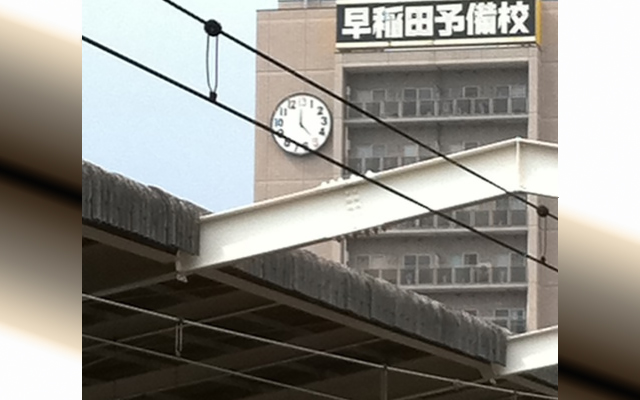
Source: Hidetoshi Yanagi [CC BY 2.0]
Prep School’s Clock Unsettles Passengers With An Eerie Additional 13th Hour
- Tags:
- 13th hour / clock / cram school / eerie / Nishi Funabashi / prep school / Waseda Yobiko
Related Article
-

The Mysterious and Misty Eerieness of Japanese Horror Illustrator Mozza
-

The wadokei: the old way of measuring time in Japan
-

Art Student Made A Clock That Writes The Time As It Elapses
-

Eerie Station With Underground Passage To Narita Airport Looks Like A Place Time Forgot
-

Artist’s embroidered pizza clock tempts you with gooey cheese pendulum action


The Nishi-Funabashi branch of Waseda Yobikō 早稲田予備校 (Waseda Prep School), a major Tokyo cram school with a 60 year history, has a very large clock attached near the top of the building.
In and of itself, a school having a clock like this is hardly an extraordinary occurrence, even if this particular clock is larger than most. Nevertheless, those who happen to stop at the platform of Nishi-Funabashi Station are likely to do a double take if they give the clock any more than a cursory glance, and for good reason:
It has an additional 13th hour on its face.
No matter what time of the day it happens to be, the minute hand always points at 13 and the hour hand at 5. Finally, the two numbers stand out from the other numbers on the clock's face through the use of a lighter shade of grey.
In other words, although it appears to be a clock, it is in fact a sign representing a clock permanently indicating 13 and 5.
Although the "clock" has been there for many years and is well known in the neighborhood (not to mention among students of the Waseda Yobikō schools), it recently came to the attention of a much larger audience after images of the clock were posted in a Tweet by creator Fukuro(Frog 96), garnering over 21,400 likes at the time of writing:
"This clock visible from the platform of Nishi-Funabashi Station exudes madness. What is this? No, seriously, what?"
What is this?
It turns out that the clock with a 13th hour is Waseda Yobikō's symbol. The school apparently even had a mascot character at one point called "13th hour kid."
But why?
In the comments following Fukuro(Frog 96)'s original tweet, several theories were mentioned:
One theory is that the numbers stand for a phrase of encouragement for students cramming to prepare for college entrance exams:
"I heard that it represents iza (13) gō (5) kaku (Let's pass the [entrance] exams)" [Note: one way of writing 1 and 3 can be i and za, and 5, go]
Another theory is that the numbers indicate the years of schooling before entering college:
"I heard that it expresses a wish to pass entrance exams since it takes 6+3+3 years of [elementary, junior high and high school] to take you until high school, a 13th year spent in cram school, and 5 meaning passing the exam."
According to an article in web media site Withnews, the two theories mentioned above were confirmed by the school's PR office. It would seem that even the school itself doesn't have an official version, and instead provides three theories as their official explanation.
The third theory is that it was meant to encourage students to study as if they had 26 hours a day. This one is probably the product of an earlier era. According to statistics provided by Japan's Ministry of Education, Culture, Sports, Science and Technology, average university rejection rates reached nearly 45% in 1990 (compared to about 7% in 2015). Those days, it was common for students who initially failed their entrance exams and needed an additional year in prep school (sometimes two, and even three, on rare occasions) to spend almost every waking hour of their lives (and even hours when they should be sleeping) studying like mad.
See the clock
If you'd like to see the clock for yourself, you can go to Nishi-Funabashi Station in Chiba Prefecture, or if you can't be bothered to make the trip, check it out on Google Street View.